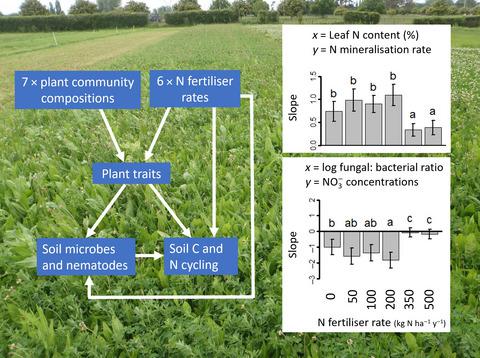当前位置:
X-MOL 学术
›
J. Appl. Ecol.
›
论文详情
Our official English website, www.x-mol.net, welcomes your
feedback! (Note: you will need to create a separate account there.)
Relationships of plant traits and soil biota to soil functions change as nitrogen fertiliser rates increase in an intensively managed agricultural system
Journal of Applied Ecology ( IF 5.0 ) Pub Date : 2020-09-26 , DOI: 10.1111/1365-2664.13771 KH Orwin 1 , NWH Mason 2 , L Aalders 3 , N Bell 3 , N Schon 4 , PL Mudge 2
中文翻译:

在集约化管理的农业系统中,随着氮肥用量的增加,植物性状和土壤生物区系与土壤功能的关系发生变化。
更新日期:2020-09-26
Journal of Applied Ecology ( IF 5.0 ) Pub Date : 2020-09-26 , DOI: 10.1111/1365-2664.13771 KH Orwin 1 , NWH Mason 2 , L Aalders 3 , N Bell 3 , N Schon 4 , PL Mudge 2
Affiliation

|
- Because plant and soil systems are strongly inter‐linked, manipulating plant traits in intensively managed agricultural systems could be used to improve soil functioning and sustainability. However, we have little understanding of whether the impacts of plant traits on soil systems are modified by other management practices, such as fertiliser use.
- We tested whether relationships among plant traits, soil biota (microbes and nematodes) and soil functions (carbon and nitrogen (N) cycling) change with N fertiliser regime in a field‐based, intensively managed experiment with high biomass removal. The experiment consisted of seven plant species compositions crossed with six N fertiliser rates (0–500 kg N ha−1 year−1).
- Relationships among plant traits, soil biota and soil functions were often consistent across N fertiliser rates. However, the relationship of percentage N2 fixer to qCO2 shifted from negative to neutral as N rates increased, and the slope of several relationships of plant traits to N cycling indicators declined when >200 kg N ha−1 year−1 was added. The negative relationship of the fungal: bacterial ratio to N cycling indicators also became neutral when > 200 kg N ha−1 year−1 was added, and the relationships of bacterivore abundance and the plant parasitic index to respiration changed direction as N inputs increased.
- Some relationships of plant traits and soil biota to soil functions were in unexpected directions. This was sometimes associated with species‐specific effects and inconsistent trait trade‐offs within species. In general, conservative plant traits and fungal dominance were associated with low N cycling and cellulose paper decomposition rates, but high respiration rates. Nematode‐based variables were better predictors of some functions than microbial ones; their incorporation into plant trait research could improve predictive power and system understanding.
- Synthesis and applications. Manipulating plant community traits can modify soil functions in intensively managed systems, but may result in larger changes where fertiliser nitrogen inputs are relatively low. Improved modelling that integrates how plant community traits, species‐specific effects and management practices interact to determine soil functions will be required before managers can confidently predict the consequences of changing plant community traits.
中文翻译:

在集约化管理的农业系统中,随着氮肥用量的增加,植物性状和土壤生物区系与土壤功能的关系发生变化。
- 由于植物和土壤系统之间有着密切的联系,因此,在集约化管理的农业系统中操纵植物性状可用于改善土壤功能和可持续性。但是,我们对植物性状对土壤系统的影响是否被其他管理措施(例如肥料的使用)所改变的了解很少。
- 我们在以高生物量去除为基础的田间密集管理试验中,测试了植物性状,土壤生物区系(微生物和线虫)和土壤功能(碳氮循环)之间的关系是否随氮肥制度的变化而变化。该实验由7种植物组成和6种氮肥施用量(0–500 kg N ha - 1 年-1)组成。
- 在氮肥施用量之间,植物性状,土壤生物区系和土壤功能之间的关系通常是一致的。然而,百分比n的关系2定影到q CO 2从负转变为中性如N速率增加,并且植物性状的几个关系到N循环指标的斜率>200千克Ñ公顷时下降-1 年-1的溶液中加入。当添加> 200 kg N ha -1 year -1时,真菌:细菌比率与N循环指标的负相关关系也变为中性,并且随着N输入的增加,噬菌体丰度与植物寄生虫指数与呼吸的关系改变了方向。
- 植物性状和土壤生物与土壤功能之间的某些关系处于出乎意料的方向。有时这与特定于物种的效应以及物种内部的性状折衷不一致有关。通常,保守的植物性状和真菌优势与低氮循环和纤维素纸分解速率有关,但与呼吸速率有关。基于线虫的变量比某些微生物更能预测某些功能。将其纳入植物性状研究可以提高预测能力和系统理解。
- 综合与应用。操纵植物群落的性状可以改变集约化管理系统中的土壤功能,但在肥料氮输入相对较低的情况下,可能导致较大的变化。在管理者能够自信地预测变化的植物群落性状的后果之前,将需要改进的模型来整合植物群落性状,特定物种效应和管理实践如何相互作用以确定土壤功能的方式。











































 京公网安备 11010802027423号
京公网安备 11010802027423号